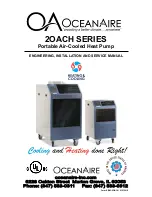
6 Commissioning/Start-up/Shutdown
38 of 72
HPK
6.3.3 Shaft seal
Shaft seals are fitted prior to delivery.
Observe the instructions on dismantling
(
ð
Section 7.4.6, Page 52)
or assembly
(
ð
Section 7.5.3, Page 56)
.
Reservoir of non-pressurised
external fluid
If applicable, fill the reservoir of non-pressurised external fluid in accordance with
the general arrangement drawing.
Double mechanical seal
Prior to starting up the pump, apply barrier pressure as specified in the general
arrangement drawing.
External liquid feed
Apply the quantities and pressures specified in the data sheet and the general
arrangement drawing.
Mechanical seal designs and types other than specified herein shall only be used in
exceptional cases and only after prior consultation with the manufacturer.
6.3.3.1 Mechanical seal for hot water
Due to the complex conditions in hot water systems, the use of mechanical seals not
approved by KSB shall not be covered by KSB's scope of warranty.
The following seal designs are used for hot water applications:
▪
Mechanical seal with external circulation
▪
Mechanical seal with air-cooled heat exchanger
6.3.3.2 Mechanical seal for thermal oil
DANGER
Improper sealing!
Severe burns! Damage to the environment!
▷
Use only mechanical seals for sealing off thermal oil > 100 °C.
DANGER
Quench supply
Serious injury!
▷
Only operate quench supply systems outdoors, far away from persons and
potential sources of ignition.
CAUTION
Contamination, deposits of cracked products and carbon residues on the seal
faces
Damage to the mechanical seal!
▷
Mechanical seal must only be operated with quench supply.
To prevent deposits of cracked products and carbon residues (from carbonised oil) on
the seal faces, use only mechanical seal systems designed to prevent contact between
oxygen and the mechanical seal faces.
The following seal designs are used for thermal oil applications:
▪
Single-acting mechanical seal with steam/nitrogen quench
If steam quench is used, the steam quench feed rate must be adjusted so that
only a small plume of steam escapes between the shaft protecting sleeve and the
throttling bush.
–
Quench medium: steam (max. 160 °C) or nitrogen
–
Required feed rate: approx. 1 kg/hour
















































